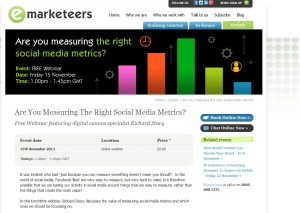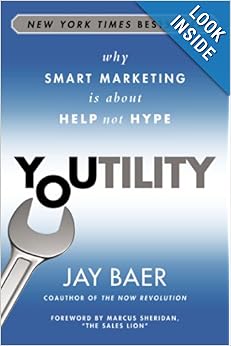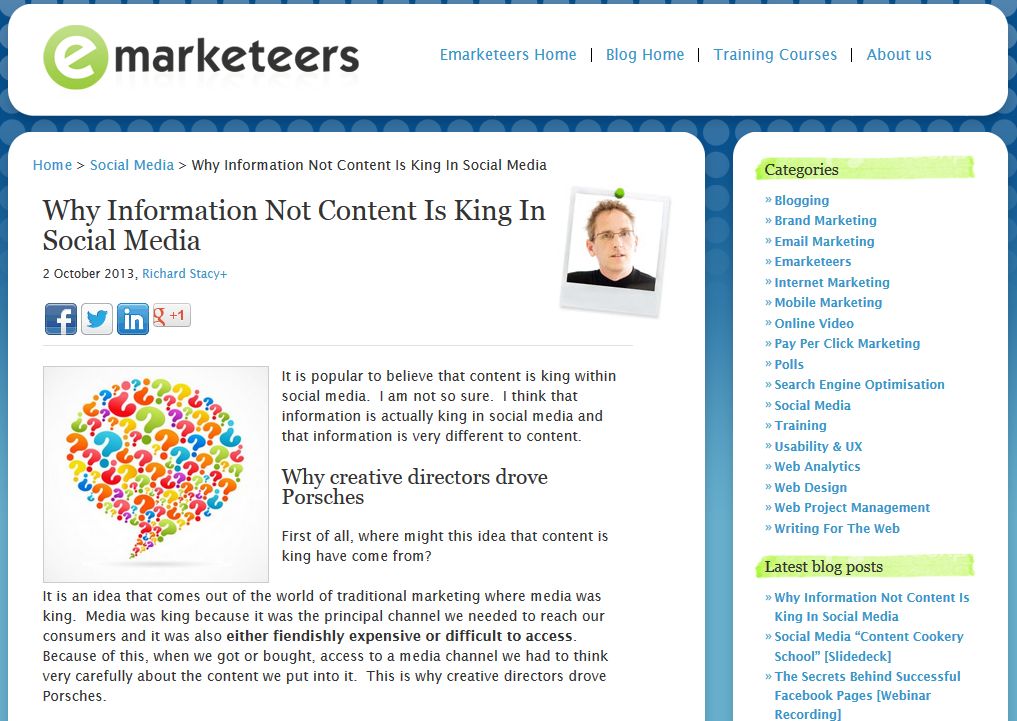The three stages of social media
Take a look out there at what organisations are doing in the world of social media and you will see there are basically three groupings: those who see it as a form of media, those who see it as a form of infrastructure and those who understand it as an agent of change.
In this piece I look at what each of these stages look like and what business opportunities (for agencies and consultancies) these stages present.
Stage One: social media as a form of media
This is the stage where organisations see social media as a way of reaching an audience, i.e. doing the job that we have always used media to do. Because it is ‘social’ media we don’t call it reaching an audience, we call it ‘engaging’ with an audience – because that sounds more social. This is the stage where the challenge is therefore seen as maximising ‘engagement’ and creating audiences of followers (we tend to call a social media audience a community – again because this sounds better). This stage usually involves the production of a great deal of content, largely because social media is seen as an extension of conventional channel and message marketing – and because there appear to be so many more channels, the task is seen as filling them with something that consumers will see as engaging. The task in this stage is identified as being a channel and message task – the same as that associated with conventional mass-marketing.
Measurement in this stage is likewise based on how we used to measure effectiveness in the world of traditional channel and message marketing – that is reach and frequency. In pursuit of reach and frequency, organisations will tend to select the tools or platforms based on where it is their consumers appear to be (our consumers are ‘on’ Facebook, therefore so should we; our consumers are posting pictures on Instagram, therefore so should we) which is an extension of the thinking behind conventional media planning.
The agency opportunities in this space are considerable. Most organisations will want to outsource the management of their various social media platforms, because they don’t have the people or skills immediately available in-house. This is a process I call social media childcare – looking after the Twitter kids if you like. Each new campaign will also need to be given a presence within social media and indeed campaigns can be created specifically to generate social media response. All of this creates business for digital, social and PR agencies and also opens up new creative and content avenues – especially in terms of video production as brands become seduced by the chance to create a viral campaign.
Stage Two: social media as a form of infrastructure
Organisations enter this stage when they realise that the real value in the social digital space is derived from understanding and responding to the way customers, and indeed employees, actually use social media. They are using it to talk to each other, have conversations and ask questions – i.e. they are using it as a form of infrastructure not as a form of media. The organisations at this stage have either got there because they have worked this out for themselves, or because they have not been able to establish what value chasing reach and frequency metrics (generating likes and maximising engagement for example) is actually delivering to the business. Incidentally, helping organisations get to this stage is what my business is about.
In stage two, the focus of social media activity will shift – away from pushing out content to an audience of people, towards listening and responding to what it is that consumers or customers actually want to talk to an organisation about. Perhaps not surprisingly, the introduction for many organisations to this stage comes from customer service, and the realisation that customer service is not just a business cost, it is a source of value creation. The task in stage two is identified as a behaviour identification and response task and the output of strategies in this stage shift from being things (messages, content, campaigns) to being processes – the process of matching answers to consumers’ questions in real time for example.
The commercial opportunities for agencies in this stage are less (one of the reasons many agencies wish to keep their clients in Stage One) but they are still considerable. The organisations which make the tools that help businesses listen and respond will do well as will the agencies that provide intelligence based on the ability to listen to relevant conversations. Within this stage, there is a much greater focus on the organisation itself, and the processes for managing flows of real-time information – creating business opportunities for those consultancies and platforms, that facilitate this.
There will still be ‘old-fashioned’ campaign-based opportunities here, simply because it will be recognised that social media presents an opportunity to allow consumers to contribute to conventional marketing activities, even if it is realised that social media is not a very effective channel to carry these activities to a significant proportion of them.
Stage Three: social media as an agent of change
This stage involves giving scale and effect to what an organisation learns in Stage Two. It is probably very difficult to get to this stage unless you have passed through Stage Two (although it is possible to get to Stage Two without passing through Stage One). It is also possible that the main trigger that will get the majority of organisations to this stage will not be an ability to proactively recognise commercial advantages, it will be the fact that consumers and customers have got here first – i.e. they are using social media to fundamentally change the markets and terms of business, and this forces organisations to react.
It has become fashionable to call organisations in this stage ‘social businesses’. Personally I don’t much like this term because it is not the purpose of business to be social, it is the purpose of business to create customers and profits. I prefer the term ‘connected business’ because this implies a business that uses the power of connection to constantly be in touch with, and responding to, the needs of all of its stakeholders (and thus be better able to create customers and profits). Stakeholders want connection and response – they don’t necessarily want a business to be social (whatever that means).
(Note: see this interesting piece by Chris Heuer, which covers this debate)
The most important thing about Stage Three is that organisations will be changing the way they operate in fundamental ways. A connected business will look, and be structured, very differently from a business that is adapted to work in the old-fashioned channel and message, command and control, world. As a result, the commercial opportunities for servicing (or creating) such businesses will lie in areas of leadership and change management counselling, management consultancy and new forms of data analytics based on the construction of algorithms and the layering datasets gathered from the explosion of data sources that are emerging as objects, as well as people, start to acquire connected, digital identities (what is being called the Internet of Things).
As you might expect, most organisations (probably 80 per cent) are at Stage One, around 19 per cent are at Stage Two and almost none have yet reached Stage Three although a larger number are starting to recognise that this represents the destination.
– Social media: its not complicated –



![FireShot Screen Capture #267 - 'There's a Camera in This Barbie Doll [VIDEO]' - mashable_com_2013_10_08_barbie-doll-camera](http://richardstacy.com/wp-content/uploads/2013/10/FireShot-Screen-Capture-267-Theres-a-Camera-in-This-Barbie-Doll-VIDEO-mashable_com_2013_10_08_barbie-doll-camera-300x234.jpg)
 It has long been
It has long been 

 A couple of weeks back I got the opportunity to attend the awards ceremony for the EACA Euro Effies. These are essentially advertising awards (or more precisely awards for advertising agencies) that are not judged by creatives for their creativity, but judged according to how effective they are in meeting the clients’ business objectives. (Should there actually be any other types of awards I ask?). The interesting thing was how little actual advertising featured in many of the winning entries. It reminded me of the sage words of Lou Capozzi , former boss of the MS&L PR network, who – on looking at the changing marcoms landscape – declared “it is all just become PR with zeros added to the budget.”
A couple of weeks back I got the opportunity to attend the awards ceremony for the EACA Euro Effies. These are essentially advertising awards (or more precisely awards for advertising agencies) that are not judged by creatives for their creativity, but judged according to how effective they are in meeting the clients’ business objectives. (Should there actually be any other types of awards I ask?). The interesting thing was how little actual advertising featured in many of the winning entries. It reminded me of the sage words of Lou Capozzi , former boss of the MS&L PR network, who – on looking at the changing marcoms landscape – declared “it is all just become PR with zeros added to the budget.”